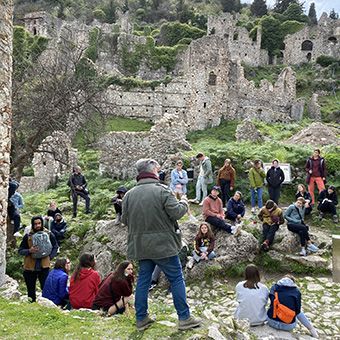
The Worlds of Medieval Greece: Tracing Byzantine, Islamicate, Slavic, Jewish, and Frankish heritages in the Aegean

Was there life in Greece after the Classics? What happened to the Greek lands after the Classical period and until Early Modern times? Who were the Byzantines and why did they call themselves Romans? And if Byzantines identified themselves as Romans, then who were the Latins from Italy, France and the rest of Western Europe who conquered much of Greece in the 13th century? What were the fortunes of the indigenous Jewish communities in Greece during Late Antiquity and the Middle Ages and how the expulsion of Jews from Spain in the 15th century resulted in a sprawling Jewish community in Thessaloniki? Did you know that an Islamic Emirate ruled much of the Aegean for two centuries? And that many placenames even in the southmost of Greece originate from the Slavic language spoken by migrating population in these areas in the early Middle Ages? Or that the Ottoman sultan in 15th c. Istanbul was regarded by many Greek speaking as the continuation of the Byzantine emperor?
The course examines the history and material culture of Greece during the expanded Middle Ages from the 4th to the 16th century by focusing of the different cultures and ethnic groups that flourished on the lands of modern-day Greece. We will follow the historical evolution from the conversion of the Roman Empire to Christianity, through the remarkable growth of Late Antique culture to the great crisis that the Great Migrations in the Balkans and the Rise of Islam in the East initiated during the 7th century. We will trace the traditions of the Greek speaking Romaniote Jews and the newly arrived in the 15th century Sephardic Jews in Greece. We will hear the subaltern voices of the non-Greek and non-Roman Slavic populations or the Arab raiders that settled in the Peloponnese and the Aegean during the Early Middle Ages. We will see in detail the Reconquista effort of the official Byzantine/Roman state to rule back and control the lands of Greece by Christianization and military force and the subsequent period of the Greek High Middle Ages (1oth-12th c). We will move on to the Crusades period and the Latin presence in the Greek peninsula in the aftermath of the Fourth Crusade (1204) and the division of the Byzantine lands among Frankish princes and Italian states. Finally, we will reach the times collapse of Byzantine and Latin rule in the wake of Ottoman conquest and the Early Modern formation of the Balkans. In addition to in-class lectures and discussions, the course will also include substantial on-site teaching, with field trips to archaeological sites and museums evidencing the presence of these groups in Medieval Greece and marking their material culture and historical heritage (such as the Byzantine and Christian Museum and the Benaki Museum in Athens, the Athens Acropolis and Roman Agora, the Byzantine monastery of Delphi).



